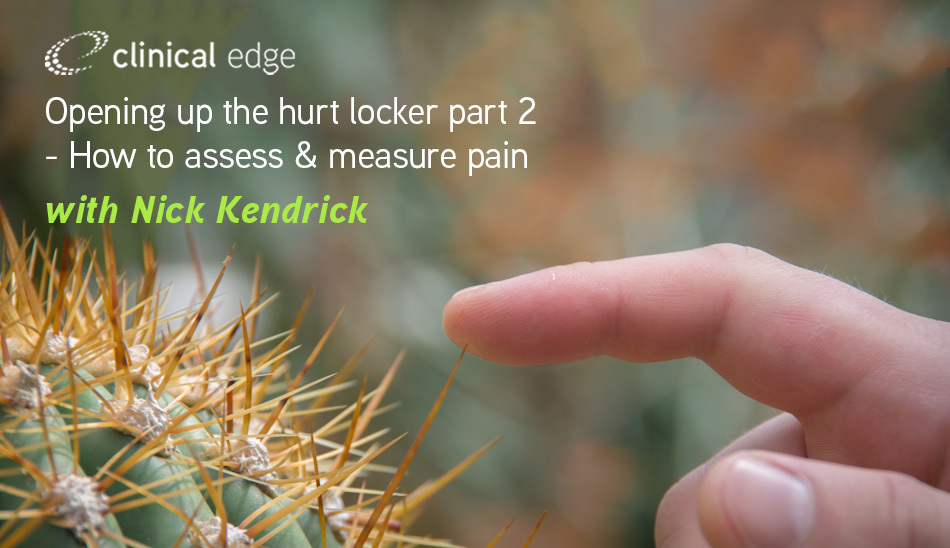Strength, sensation and reflex testing is normal and expected in patients with neuro symptoms, neck pain past the shoulder, and low back pain past the gluteal fold. In Opening the hurt locker part 1, Nick Kendrick (APA Titled Musculoskeletal & Sports and Exercise Physiotherapist) demonstrated the most accurate and efficient ways to assess strength, sensation, reflexes, and neurodynamics. If your neuro assessment stops there, you may be missing vital pieces of the puzzle that will help you identify what’s responsible for your patients symptoms, and how to approach their treatment.
Now available - Opening up the hurt locker part 2 - How to assess & measure pain with Nick Kendrick
Discover what most therapists miss in their neuro assessment, improve your neuro assessment accuracy, and successfully treat patients with neurological symptoms with this presentation with Nick Kendrick (APA Titled Musculoskeletal & Sports and Exercise Physiotherapist). You’ll discover:
-
Why some patients with low back pain keep performing provocative activities or postures that aggravate their symptoms eg. slouched sitting.
-
How to identify when decreased body awareness and ability to perceive sensory and motor cues (tactile acuity) are contributing to your patients pain.
-
When your patients have poor body awareness and tactile acuity, which assessment tests will help you find the cause and improve your patients body awareness and pain.
-
If your patient is a diabetic office worker with pins & needles or numbness in their thumb, index and middle fingers, how to identify if their neurological symptoms are due to cervical radiculopathy, carpal tunnel syndrome or diabetic neuropathy.
-
Why nerve conduction studies often show full nerve conduction, despite your patient having clear neuro symptoms.
-
How to stun your patients and neurologists with an accurate clinical diagnosis of nerve fibre conduction issues that even nerve conduction studies missed.
-
Improve your assessment & diagnostic accuracy with peripheral nerve palpation of:
- Cranial nerves in your headache and neck pain patients.
- Upper limb nerves in your cervical radiculopathy, carpal tunnel and other upper limb symptom patients - Brachial plexus, ulnar, median and radial nerves.
- Hip, groin and abdominal nerves in your hip and groin pain patients - Ilioinguinal, iliohypogastric, genitofemoral.
- Lower limb nerves in your low back, knee and lower limb pain patients - sciatic, tibial, peroneal, sural and all three branches of the saphenous nerve in knee pain patients.
-
How to perform simple clinical sensory testing to identify
- Small nerve fibre neuropathies when your patient has neuro symptoms and nerve conduction studies are clear.
- Temporal summation - pain ramping up with repeated pressure, movement or activities.
- Nociplastic pain, allodynia and hyperalgesia (increased pain response), when your patient has widespread hyperalgesia, or hyperalgesia outside of neuro-anatomically plausible distributions.
-
How clinical sensory testing guides your treatment, so you know when to use and when to avoid manual therapy or specific exercises, and when to refer for further investigations and medical care.
-
How to assess and treat tactile acuity and body awareness when your patient continues to use unhelpful body positions and postures that aggravate their symptoms.
-
When imaging and conduction studies are indicated and provide valuable information in patients with nerve symptoms or involvement, including:
- Nerve conduction studies
- Ultrasonography
- MRI
- fMRI
- EEG
- MEG (Magnetoencephalography)
- PET (Positron Emission Tomography)
- Microneurography
- Skin biopsy
-
How to use your assessment to get a clear diagnosis, and know exactly how to treat patients with neurological symptoms, hyperalgesia, nociplastic and ongoing pain.
CLICK HERE to improve your assessment & diagnostic skills with a free trial Clinical Edge membership

